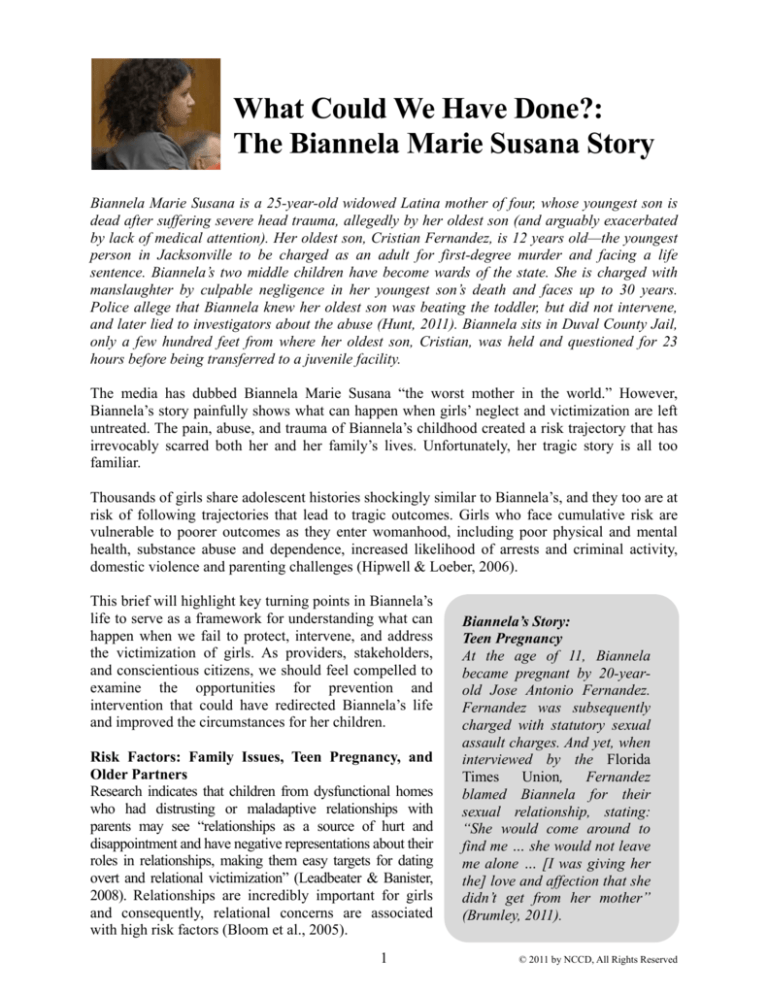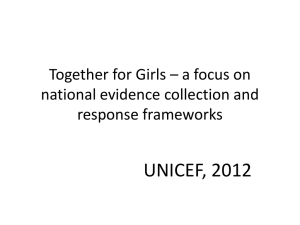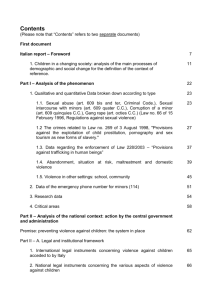
What Could We Have Done?:
The Biannela Marie Susana Story
Biannela Marie Susana is a 25-year-old widowed Latina mother of four, whose youngest son is
dead after suffering severe head trauma, allegedly by her oldest son (and arguably exacerbated
by lack of medical attention). Her oldest son, Cristian Fernandez, is 12 years old—the youngest
person in Jacksonville to be charged as an adult for first-degree murder and facing a life
sentence. Biannela’s two middle children have become wards of the state. She is charged with
manslaughter by culpable negligence in her youngest son’s death and faces up to 30 years.
Police allege that Biannela knew her oldest son was beating the toddler, but did not intervene,
and later lied to investigators about the abuse (Hunt, 2011). Biannela sits in Duval County Jail,
only a few hundred feet from where her oldest son, Cristian, was held and questioned for 23
hours before being transferred to a juvenile facility.
The media has dubbed Biannela Marie Susana “the worst mother in the world.” However,
Biannela’s story painfully shows what can happen when girls’ neglect and victimization are left
untreated. The pain, abuse, and trauma of Biannela’s childhood created a risk trajectory that has
irrevocably scarred both her and her family’s lives. Unfortunately, her tragic story is all too
familiar.
Thousands of girls share adolescent histories shockingly similar to Biannela’s, and they too are at
risk of following trajectories that lead to tragic outcomes. Girls who face cumulative risk are
vulnerable to poorer outcomes as they enter womanhood, including poor physical and mental
health, substance abuse and dependence, increased likelihood of arrests and criminal activity,
domestic violence and parenting challenges (Hipwell & Loeber, 2006).
This brief will highlight key turning points in Biannela’s
life to serve as a framework for understanding what can
happen when we fail to protect, intervene, and address
the victimization of girls. As providers, stakeholders,
and conscientious citizens, we should feel compelled to
examine the opportunities for prevention and
intervention that could have redirected Biannela’s life
and improved the circumstances for her children.
Risk Factors: Family Issues, Teen Pregnancy, and
Older Partners
Research indicates that children from dysfunctional homes
who had distrusting or maladaptive relationships with
parents may see “relationships as a source of hurt and
disappointment and have negative representations about their
roles in relationships, making them easy targets for dating
overt and relational victimization” (Leadbeater & Banister,
2008). Relationships are incredibly important for girls
and consequently, relational concerns are associated
with high risk factors (Bloom et al., 2005).
1
Biannela’s Story:
Teen Pregnancy
At the age of 11, Biannela
became pregnant by 20-yearold Jose Antonio Fernandez.
Fernandez was subsequently
charged with statutory sexual
assault charges. And yet, when
interviewed by the Florida
Times
Union,
Fernandez
blamed Biannela for their
sexual relationship, stating:
“She would come around to
find me … she would not leave
me alone … [I was giving her
the] love and affection that she
didn’t get from her mother”
(Brumley, 2011).
© 2011 by NCCD, All Rights Reserved
For Biannela, one of the risk factors associated with relational concerns was involvement with an
older partner. Having an older partner, in particular, is associated with risky sexual behavior,
pregnancy, childbirth, truancy, substance use, unwanted sexual experiences, and dating violence
(Abma et al., 1998; Buzy et al., 2004; Darroch et al., 1999; Manlove et al., 2006; Miller et al.,
1997; Rickert et al., 2004).
Unfortunately, Biannela found herself experiencing many of these negative outcomes at a young
age. At the age of 12, Biannela gave birth to her first son, Cristian Fernandez. Young mothers
may lack the skills, experience, and maturity level needed for healthy parenting, which could
impact child behavior and development (Levine, Pollack, & Comfort, 2001). As such, the
children of teen mothers may exhibit problems in school such as poor academic skills, repeating
a grade, early school dropout, as well as initiating early sexual activity, early parenthood, risky
behavior, violent offending, and unemployment (Jaffee, Caspi, Moffitt, Belsky, & Silva, 2001;
Levine, Pollack & Comfort, 2001).
Critical Points of Intervention
School
Authority figures and key people who knew Biannela and were aware of her situation could have
intervened. Biannela should have been in middle school with multiple teachers and
administrators who would have known about her pregnancy. As teen pregnancy is a risk factor
for truancy, school failure, and dropout, intervention is critical.
•
Biannela’s presence in school and obvious pregnancy offered an opportunity for
teachers to engage and encourage her participation at school. Likewise, the school
administrators can attempt to connect young pregnant girls with school
counselors/outside referrals.
Medical Professionals
The doctors and nurses who delivered Biannela’s son were another possible point of intervention.
As the research shows, fostering strong parent-child attachments, bonding, and positive
relationships can encourage more positive outcomes (Arbona & Power, 2003).
•
This presented an opportunity to offer Biannela parenting education or support
programs for teen parents. Many interventions with young mothers have
demonstrated effectiveness. At a minimum, young mothers should receive support
services and be informed of places to go for advice.
•
It is unclear what level of support and guidance Biannela had from her mother or
extended family members. As such, quality daycare would have been critical to
Biannela attending school and baby Cristian receiving adequate and safe
supervision.
Law Enforcement
Law enforcement officials who arrested the baby’s father for statutory sexual assault were a third
point of possible intervention. Often pre-teen mothers who are this young require even more
specialized interventions.
2
© 2011 by NCCD, All Rights Reserved
•
The provision of counseling and other social services could have addressed early
sexual activity and Biannela’s relationship with her older partner. Girls need
someone to talk to who can help guide them to establish safety for themselves and
with others, to recognize healthy and unhealthy relationships, and to deal with
depression and other common mental health problems (Chesney-Lind et al.,
2008).
The confluence of risk factors and the precarious situation in which Biannela and her new baby
found themselves called for immediate intervention. Unfortunately, the services Biannela and her
infant desperately needed were likely inaccessible to them. The system’s response and the
policies and practices are a critical component. The individual characteristics of the mother and
her unique risk factors must be considered when designing interventions and providing services
to help teen mothers and their children (Jaffee, Caspi, Moffitt, Belsky, & Silva, 2001).
Risk Factor: Neglect and Welfare System Involvement
The circumstances leading to Biannela and Cristian’s removal
from Biannela’s mother’s home were undeniably traumatic.
Though it is uncertain how long Biannela and her son were
placed in foster care, involvement in the child welfare system
is associated with its own set of negative outcomes including
conduct problems and delinquency. Research has consistently
shown that children in the foster care system have high rates
of behavioral, emotional, developmental, and even physical
problems, which require specialized services and attention
(Taussig, Clyman, & Landsverk, 2001). Equally traumatic is
the residential instability that results from placement. Existing
research suggests strong associations between family
instability and the disruption caused by residential moves and
adolescent adjustment problems (Adam & Chase-Lansdale,
2002). Additionally, residential instability can result in social,
emotional, and educational dysfunction.
Biannela’s Story:
Teen Motherhood
At the age of 14, Biannela
was found walking
around a South Florida
motel—her toddler was
“dirty and naked”—while
the toddler’s
grandmother, who would
have been about 34 at the
time, “nursed a drug
habit inside” (Hunt,
2011). Mother and son
were placed in foster
care.
Critical Points of Intervention
Child Welfare
For Biannela, intervention with her mother and in her family life was critical to breaking the
cycles of abuse and victimization that had marked her life. Though details about her relationship
with her mother are unclear, the neglect and maltreatment likely strained their relationship.
•
Structure and support at home to encourage healthy relationships and positive
choices was made difficult by Biannela’s mother’s neglect and substance abuse.
Therefore, counseling, parent support groups, and other services and
programming were desperately needed.
Foster Care
•
Given the high level of need, the foster care system had the opportunity to
identify these needs and provide appropriate services.
3
© 2011 by NCCD, All Rights Reserved
Risk Factors: Abuse/Domestic Violence in Home
Sadly, for Biannela and her children, the cycle of
intergenerational abuse and violence suggests that
children exposed to physical abuse are predisposed to
violence later in life (Widom & Maxfield, 2001). When
a child witnesses and experiences violence there is a
greater likelihood that the child will deem violence as
an acceptable tool. Existing research findings indicate
that in fact “violent childhood experiences are related to
attitudes towards the use of violence against … and
frequency of violence against both children and
spouses” (Markowitz, 2001).
Biannela’s Story:
Continued Trauma in Adulthood
For Biannela, the cumulative
risk factors became a tragic
reality. From age 19–23,
Biannela had three more
children. In her early twenties,
Biannela married Luis
Galarraga-Blanco. The Florida
Times Union reported that
Galarraga-Blanco was an
abusive, volatile man with a
heated temper (Brumley, 2011).
After allegations of physical and
sexual abuse toward Cristian
(his stepson) and an impending
arrest by officials, GalarragaBlanco shot himself in the head
in front of Biannela’s younger
children (Brumley, 2011).
Research suggests that the effects of in-home violence
are experienced differently by boys and girls. While
girls translate the experience of violent families into
internalizing behavioral problems, boys report
internalizing and externalizing behavior as well as
adjustment disorders (Jaffee, Wolfe, & Zak, 1986).
Additionally, an empirical evaluation of the role that
intergenerational violence plays in the expression of
aggression in witnesses suggests that, for males,
exposure to aggression predicts aggressive behavior
(Doumas, Margolin, & John, 1994). Extrapolating from
this research helps to better contextualize Cristian’s alleged actions. It is likely that his exposure
to violence in the home would have predisposed him to use violence when dealing with his
youngest brother.
Critical Points of Intervention
Perhaps the most tragic part of Biannela and her children’s story is that following the allegations
of abuse and her husband’s suicide, officials did not intervene. In a letter to the Florida Times
Union, Biannela said that “state officials knew of troubles in her home … months after her
husband committed suicide in front of some of the family … [and] officials from the Department
of Children and Families put Cristian and her other children on a waiting list for therapy. The
counseling and child care help they promised never came,” she wrote (Murphy, 2011).
Child Welfare
•
Given the extreme trauma and multiple allegations of abuse and victimization,
this family was in severe need of help. Efforts must be made to provide services
to families who have experienced multiple and sustained trauma.
•
Teachers at Cristian’s school saw the signs of abuse and followed up with
officials. The role of teachers and schools is critical in efforts to intervene and
address child abuse.
School
4
© 2011 by NCCD, All Rights Reserved
Community Services
•
•
•
The lack of access to critical services suggests that the early prevention and
intervention services in Biannela’s South Florida community were underfunded,
fragmented, or operated independently, which created the opportunity for her case
to fall through the cracks.
Efforts must be made to help clients navigate multiple systems and better
understand the services that are available, how to access them, and connecting
them with providers who are trauma informed and culturally competent.
As a young girl, Biannela’s life experiences created cumulative risk, placing her
in danger of negative adult outcomes. Additionally, teen pregnancy coupled with
an abusive relationship with her partner further accelerated her trajectory and her
children’s risk. For Biannela, these risk factors were ignored or inadequately
addressed at multiple points by numerous systems.
Many points of intervention were missed and the services Biannela and her children desperately
needed were either denied or never came to fruition. Had the necessary prevention and
intervention services been available, one can only speculate that the tragic death of her
Biannela’s youngest son, David, and the impending trial of her eldest son, Cristian, as well as her
own charges may have been prevented. The risk trajectories of her other two children, who are
now in foster care, could also look different. Biannela was invisible to us as a young girl, but the
tragedy of her story is very visible in the media now. As a community, are we prioritizing
prevention and intervention in the lives of girls at risk?
5
© 2011 by NCCD, All Rights Reserved
6
© 2011 by NCCD, All Rights Reserved
REFERENCES
Abma, J., Driscoll, A., & Moore K. (1998). Young women’s degree of control over first
intercourse: an exploratory analysis. Family Planning Perspectives, 30(1), 12–18.
Adam, E.K., & Chase-Lansdale, L. (2002). Home sweet homes: parental separations, residential
moves, and adjustment problems in low-income girls. Developmental Psychology, 38(5).
Arbona, C., & Power, T. G. (2003). Parental attachment, self-esteem, and antisocial behaviors
among African American, European American, and Mexican American adolescents.
Journal of Counseling Psychology, 50(1), 40–51.
Bloom, B., Owen, B. & Covington, S. (2005). Gender-Responsive Strategies for Women
Offenders: A Summary of Research, Practice, and Guiding Principles for Women
Offenders. Washington, DC: National Institute of Corrections. NIC accession no. 020418.
Brumley, J. (2011, June 12). Father, former neighbors stunned by murder charge against Cristian
Fernandez. Florida Times Union. Retrieved from
http://jaxairnews.jacksonville.com/news/crime/2011-06-11/story/father-formerneighbors-stunned-murder-charge-against-cristian-fernandez?page=1#ixzz1bPyE2JZp
Buzy, W. M., McDonald, R., Jouriles, E. N., Swank, P. R., Rosenfield, D., Shimek, J. S., et al.
(2004). Adolescent girls’ alcohol use as a risk factor for relationship violence. Journal of
Research on Adolescence, 14(4), 449-470.
Chesney-Lind, M., Morash, M., & Stevens, T. (2008). Girls’ troubles, girls’ delinquency, a
gender responsive programming: A review. Australian and New Zealand Journal of
Criminology, 41(1), 162-189.
Darroch, J.E., Landry, D.J., & Oslak, S. (1999). Age differences between sexual partners in the
United States. Family Planning Perspectives, 31(4), 160–167.
Doumas, D., Margolin, G., & John, R.S. (1994). The intergenerational transmission of aggression
across three generations. Journal of Family Violence, 9(2).
Hipwell, A., & Loeber, R. (2006). Do we know which interventions are effective for disruptive
and delinquent girls? Clinical Child and Family Psychology Review, 9(3/4), 221–255.
Hunt, D. (2011, June 3). Defense: 12-year-old charged in toddler's death was abused, neglected
as child: Grandmother abused drugs, father spent time in prison and stepfather shot
himself. Florida Times Union. Retrieved from http://jacksonville.com/news/crime/201106-03/story/defense-12-year-old-charged-toddlers-death-was-abused-neglected-child
Hunt, D. (2011, June 4). Boy, 12, charged in slaying, had tumultuous upbringing. Florida Times
Union. Retrieved from http://jacksonville.com/news/crime/2011-06-04/story/boy-12charged-slaying-had-tumultuous-upbringing
Jaffe, P., Wolfe, D., & Zak, L. (1986). Family violence and child adjustment: A comparative
analysis of girls’ and boys’ behavioral symptoms. American Journal of Psychiatry, 143.
7
© 2011 by NCCD, All Rights Reserved
Jaffee, S., Caspi, A., Moffitt, E.T., Belsky, J., & Silva, P. (2001). Why are children born to teen
mothers at risk for adverse outcomes in young adulthood? Results from a 20-year
longitudinal study. Developmental Psychology, 4(2), 377–397.
Leadbeater, B.J., & Banister, E.M. (2008). Victimization and relational aggression in adolescent
romantic relationships: The influence of parental and peer behaviors, and individual
adjustment. Journal of Youth Adolescence, 37, 359–372.
Levine, J.A., Pollack, H., & Comfort, M.E. (2001). Academic and behavioral outcomes among
the children of young mothers. Journal of Marriage and Family, 63(2), 355–369.
Manlove, J., Terry-Humen, E., & Ikramullah, E. (2006). Young teenagers and older sexual
partners: Correlates and consequences for males and females. Perspectives on Sexual and
Reproductive Health, 38(4), 197–207.
Markowitz, F.E. (2001). Attitudes and family violence: Linking intergenerational and cultural
theories. Journal of Family Violence, 16(2), 205–218.
Miller K.S., Clark L.F., Moore J.S. (1997) “Sexual initiation with older male partners and
subsequent HIV risk behavior among female adolescents”, Family Planning Perspectives,
Sep-Oct; 29(5): 212-4.
Murphy, B. (2011, August 31). Cristian Fernandez’s mom responds to T-U with letter: Jailed
mom grieves for one son, agonizes for another. Florida Times Union. Retrieved from
http://jacksonville.com/news/crime/2011-08-31/story/cristian-fernandezs-mom-respondst-u-letter
Rickert, V. I., Wiemann, C. M., Vaughan, R. D., & White, J. W. (2004). Rates and risk factors
for sexual violence among an ethnically diverse sample of adolescents. Archives of
Pediatrics & Adolescent Medicine, 158(12), 1132-1139.
Taussig, H.N., Clyman, R.B., & Landsverk, J. (2001). Children who return home from foster
care: A 6-year prospective study of behavioral health outcomes. Pediatrics, 108(1).
Widom, C., & Maxfield, M. (2001). An update on the “cycle of violence.” Washington, D.C.
National Institute of Justice, Research in Brief. U.S. Department of Justice, Office of
Justice Programs.
8
© 2011 by NCCD, All Rights Reserved










